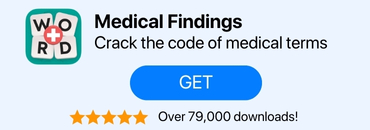We’re back with the second part of the quiz on the most common root words and combining forms that are used to describe respiratory systems.
Quick Review for the Quiz
Check out the flashcard version for a more detailed review.
| Word Root | Combining Form | Body Part or Condition |
|---|---|---|
| oo, ov | oo, ov/o, ov/i | ovum, egg cell |
| ovari, oophor | ovari/o, oophor/o | ovary |
| para | para | has given birth |
| pelv | pelv/i |
pelvis, pelvic bones or pelvic cavity
|
| perine | perine/o | perineum |
| salping | salping/o |
uterine tube or fallopian tube
|
| toc | toc/o | labor |
| uter, metr, hyster | uter/o, metr/o, metr/i, hyster/o | uterus |
| vagin, colp | vagin/o, colp/o | vagina |
| vulv, episi | vulv/o, episi/o | vulva |
-
Question of
Find the combining form of the image highlighted.

-
ov/o
-
egg/o
-
ovum/o
-
men/o
Correct Wrong
oo, ov/o or ov/i is a combining form that refers to "ovum" or "egg cell". Ovum is a single cell found in one of the female reproductive organs, the ovaries, capable of developing into a fetus when fertilized with sperm. The egg is about 30 times wider than sperm.
-
-
Question of
Find the combining form of the image pointed to.

-
ovari/o
-
egg/o
-
pelv/i
-
fet/o
Correct Wrong
ovari/o or oophor/o is a combining form that refers to "ovary". The ovary is a female reproductive organ that releases eggs (ovum) and the hormones estrogen and progesterone. Female traits such as hair growth, breast development, and body shape are shaped by these hormones. Additionally, these hormones affect the cycle of menstruation and fertility.
-
-
Question of
Find the combining form of the image highlighted.

-
para
-
birth/o
-
nat/i
-
poro
Correct Wrong
para is a combining form that refers to "has given birth" or "parity" (Note: this is different from the prefix Para- which means nearby or alongside). Parity refers to the number of times a woman has given birth to a fetus who is 24 weeks or older. This is whether the child is alive or dead.
-
-
Question of
Find the combining form of the image highlighted.

-
pelv/i
-
hip/o
-
metr/i
-
hyster/o
Correct Wrong
pelv/i is a combining form that refers to "pelvis", "pelvic bones" or "pelvic cavity". The pelvis is a basin-shaped bone that protects the abdominal organs and supports the spinal column. In the bony pelvis, there are two parts: the anterior and the posterior. In the anterior part of the pelvis, you find the pubis, the ischium, and the ilium. It is attached posteriorly to the pelvic spine. Coccyx and sacrum make up the pelvic spine.
-
-
Question of
Find the combining form of the image pointed to.

-
perine/o
-
endometri/o
-
vagin/o
-
toc/o
Correct Wrong
perine/o is a combining form that refers to "perineum". Female perineum consists of the area between the anus and genitals, which extends from the vaginal opening to the anus. Typically, it is 2 to 5 centimeters long. Pelvic floor muscles connect with the muscles in the perineum. In childbirth, the perineum stretches to accommodate the baby.
-
-
Question of
Find the combining form of the image pointed to.

-
salping/o
-
fallop/o
-
clitorid/o
-
men/o
Correct Wrong
salping/o is a combining form that refers to "uterine tube" or "fallopian tube". The fallopian tubes connect the ovaries to the uterus. Through the fallopian tubes, eggs move from the ovaries to the uterus. Fertilization takes place at these sites as well.
-
-
Question of
Find the combining form of the image highlighted.

-
toc/o
-
labor/o
-
embry/o
-
birth/o
Correct Wrong
toc/o is a combining form that refers to "labor". The process of labor is characterized by continuous, progressive contraction of the uterus that assists in dilation (opening) and efface (thinning) of the cervix. In this way, the fetus can move through the birth canal.
-
-
Question of
Find the combining form of the image pointed to.

-
metr/o
-
ovari/o
-
ov/i
-
vulv/o
Correct Wrong
uter/o, metr/o, metr/i or hyster/o is a combining form that refers to "uterus". Uterus is a muscular hollow organ situated between the bladder and rectum in females. During pregnancy, a fetus (unborn baby) develops and grows in the uterus. The uterus is also called the womb.
-
-
Question of
Find the combining form of the image pointed to.

-
colp/o
-
canal/o
-
para
-
perine/o
Correct Wrong
vagin/o or colp/o is a combining form that refers to "vagina". The vagina is an essential passage that plays a role in sexual activity, menstruation, pregnancy, and childbirth.
-
-
Question of
Find the combining form of the image pointed to.

-
episi/o
-
genital/o
-
perine/o
-
hymen/o
Correct Wrong
vulv/o or episi/o is a combining form that refers to "vulva". An outer part of a female's genital system is the vulva. There are three parts to the vulva: the opening of the vagina, the labia majora (outer lips), and the labia minora (inner lips). In addition to protecting female reproductive organs (labia majora and minora), the vulva also plays a role in sexual arousal and stimulation (clitoris) and facilitates sex through the provision of lubrication (Bartholin's glands) and cushioning (mons pubis).
-




